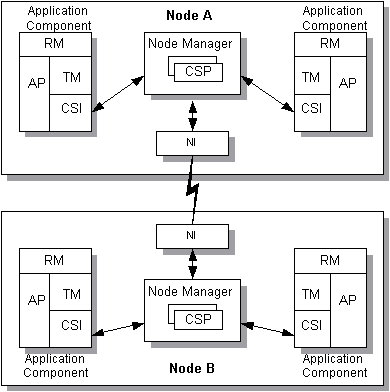
 |
| e-docs > Tuxedo > Using the Tuxedo TOP END Domain Gateway with ATMI Applications > Introducing the BEA Tuxedo TOP END Domain Gateway |
|
Using the Tuxedo TOP END Domain Gateway with ATMI Applications
|
Introducing the BEA Tuxedo TOP END Domain Gateway
This topic includes the following sections:
What Is the TOP END Domain Gateway?
BEA Tuxedo Domains provide a framework for interoperability between the domains of a business that require administrative autonomy but allow sharing of services and data. The TOP END Domain Gateway (TEDG) extends the BEA Tuxedo Domains concept to include BEA TOP END interoperability. The TEDG supports transactional message passing and queuing between the BEA TOP END and BEA Tuxedo systems.
Features of the TOP END Domain Gateway
The TOP END Domain Gateway provides the following features:
Message Passing
Message passing provides bi-directional communication between BEA TOP END and BEA Tuxedo user components. The primary message passing capabilities are:
Queue Processing
Queue processing capabilities include:
Transactional Support
Transactional support allows global transactions to span BEA Tuxedo systems and BEA TOP END systems. That is, if a global transaction is begun in a component of one product and subsequent messages or enqueuing operations are sent to components in another product, the scope of the transaction includes work performed by components in the second product.
Security
The TOP END Domain Gateway provides the following security methods for communications:
See Also
Understanding How the TOP END Domain Gateway Works
This topic includes the following sections:
BEA Tuxedo and BEA TOP END Terminology
While BEA Tuxedo and BEA TOP END offer similar capabilities, the terminology used by each product family is different. The following table provides a comparison of BEA TOP END and BEA Tuxedo terminology.
TEDG Terminology The following table summarizes common terminology used in reference to the TEDG.
Reference Manual Notation TEDG users should keep in mind that references to entries in the BEA TOP END Programmer's Reference Manual are marked by a "T" after the section number included in the reference. For example, the tp_intro(1T) entry can be found in the BEA TOP END Programmer's Reference Manual. Entries referenced without a "T" after the section number (such as tmboot (1)) can be found in the appropriate section of the BEA Tuxedo reference manual:
BEA Tuxedo Architecture Overview
The BEA Tuxedo system uses the concept of a domain to define a collection of nodes (or machines) involved in an administratively autonomous application. A system administrator uses two files, UBBCONFIG and DMCONFIG, to configure a BEA Tuxedo domain.
A distributed-domain configuration consists of one or more business applications running on multiple machines. Although it contains multiple machines, this type of configuration is considered a single domain because it is administered centrally as a single entity. The following diagram shows the basic parts of a configuration distributed across multiple machines.
Figure 1-1 BEA Tuxedo Distributed Configuration
The primary components of a distributed configuration are:
A multiple-domain configuration consists of two or more domains that communicate with each other through a gateway process in each domain. This gateway process provides bidirectional transaction control, and administrative tools that allow the configuration of the information required for interoperability of the local application with other domains. This configuration information includes the identification of a set of exported services, imported services, addressing, and access control. For an illustration of a multiple-domain configuration, see "BEA Tuxedo ATMI Infrastructure" on page 3-2 in Introducing BEA Tuxedo ATMI.
See Also
BEA TOP END Architecture Overview
The basic architecture of a BEA TOP END system is shown in the following figure.
Figure 1-2 Basic BEA TOP END System Architecture
As shown in the figure, a BEA TOP END system consists of one or more nodes. A basic node consists of a client, a node manager, and a server.
An Application Component consists of the following:
The network interface (NI) is an optional component in a BEA TOP END system. An NI is not required for single-node systems. The Network Interface:
See Also
How the TEDG Works
The TOP END Domain Gateway (TEDG) provides interoperability between BEA TOP END systems and BEA Tuxedo Domains. The TEDG consists of two parts: a gateway administrative server and a gateway process.
Each GWADM/GWTOPEND pair represents an instance of the TEDG. Multiple instances can be configured by specifying multiple GWADM/GWTOPEND pairs, one pair per BEA Tuxedo group.
The following illustration shows how the TEDG connects a BEA TOP END system and a BEA Tuxedo domain.
Figure 1-3 Connecting Systems with the TOP END Domain Gateway
How a BEA Tuxedo User Views the TEDG From the perspective of a BEA Tuxedo system user, the TEDG:
How a BEA TOP END User Views the TEDG
From the perspective of a BEA TOP END system user, the TEDG:
See Also

|

|

|